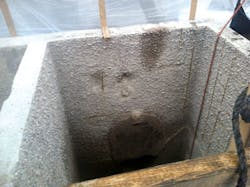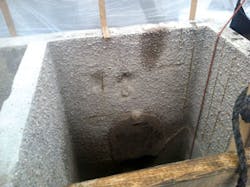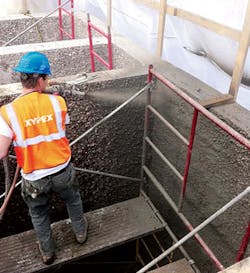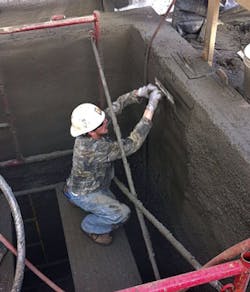Future-Proof Protection: Eighty-Year-Old Siphon Chamber Gets New Life with Crystalline Waterproofing
The challenges of aging, deteriorating infrastructure and limited funding are ones that public works agencies across the country face every day. Those charged with managing sanitary sewer and waste treatment plants have the added challenge of dealing with chemical attacks from various aggressive agents such as hydrogen sulfide (H2S) gas. The management of H2S is particularly challenging, especially in warm climates or in systems with low velocity flow.
The La Crosse Public Works Department in the city of La Crosse, Wis., is looking beyond conventional solutions to repair and rehabilitate its concrete wastewater systems, extending the lifespan of existing infrastructure and minimizing the need for future maintenance with help from crystalline waterproofing technology, as demonstrated in the recent rehabilitation of a vital wastewater flow chamber.
Acid Attack
The Mississippi Street siphon concrete chamber is a critical part of the Isle La Plume wastewater treatment plant (WWTP) system serving the city of La Crosse.
During a routine inspection, engineers noted that the surfaces of the concrete siphon chamber showed signs of significant deterioration from microbial induced corrosion (MIC), which is a direct result of H2S gas. MIC leads to both acid attack as well as deterioration of the concrete from an expansive sulfate reaction. In some areas, concrete losses in the 20 x 11 x 18-foot chamber were as deep as 3 to 4 inches.
Constructed around the same time as the Isle La Plume WWTP in the 1930s, the chamber once acted as a combined storm and sanitary sewer overflow structure. When the secondary aeration facility was constructed in the 1970s, the city separated the storm and sanitary flows, overflow capabilities were taken out of service, and the pipe to the slough was closed. The internal siphon chamber was then modified so that all flows were directed to the treatment plant.
Today, the more than 80-year-old siphon chamber directs about one-third of the area's wastewater flow to the nearby Isle La Plume WWTP. However, the public works agency needed a way to protect the concrete substrate.
Soon after the initial inspection, the La Crosse Department of Public Works initiated a rehabilitation project to repair the concrete chamber, replace the flow control gates and construct a bypass pumping manhole. Site work also included replacing the maintenance stairs to the chamber and re-landscaping the heavily sloped site.
Wapasha Construction of Winona, Minn., was selected to complete the performance-based contract.
Alternative Repair
The initial specification called for concrete repair and installation of a polyurethane lining system with a five-year guarantee of success. However, the team decided against the lining system because of the very damp conditions inside the chamber.
Working with the inspection contractor, Dixon Engineering, Wapasha recommended switching to a Xypex crystalline waterproofing material and resurfacing mortar that could be installed in the wet conditions found in the siphon chamber.
Xypex crystalline technology uses water in the capillary tracts as a diffusing medium to carry waterproofing chemicals into the concrete. The chemicals migrate through the waterways of the saturated pore network, where they react and grow insoluble, needle-like crystals that plug the pores. Within a few weeks of crystal growth, liquids can no longer pass through and the transmission of gases is restricted. The effect is permanent. In fact, the technology self-seals static hairline cracks up to a width of 0.4 mm, and if new cracking occurs -- even years after the original application -- the crystalline formation will reactivate to seal them.
Crystalline waterproofing has been applied on concrete water and wastewater treatment systems around the world. In all cases, the crystalline waterproofing technology is non-toxic and contains no volatile organic compounds (VOCs). This makes the crystalline material an ideal solution for applications in confined spaces.
The effectiveness of crystalline waterproofing in the field is backed by extensive independent laboratory testing for permeability, crack sealing and chemical resistance. Permeability testing, in accordance with U.S. Army Corps of Engineers' (ACE) CRD C-48-73, Permeability of Concrete, demonstrated that crystalline-treated concrete could withstand up to 405 feet (123 m) of head pressure, or 1.2 MPa (175 psi), which was the limit of the testing apparatus.
Long-Term Value
To use crystalline waterproofing on existing concrete, the substrate must be clean and free of laitance, dirt, film, paint, coating, or other foreign matter prior to treatment. Surfaces must also have an open capillary system to provide "tooth and suction" for the coating to adhere and gain access to the pore network.
In the case of the La Crosse siphon chamber, the contractor first blasted the concrete clean with high-pressure, water-based abrasive and then installed Xypex Megamix II resurfacing mortar to thicknesses ranging between 2 and 3 inches.
"The Mississippi siphon concrete chamber was in rough shape," said James Orr, NACE inspector with Dixon Engineering. "I liked the fact that the Xypex Megamix II could be applied to a damp surface while allowing thicknesses of 2 to 3 inches of restorative mortar to be applied in one application."
Water and wastewater systems waterproofed and protected with crystalline technology have clear advantages over traditional barrier methods in terms of application, convenience and cost. Designed to create an integral crystalline structure in the pores and capillary tracts of the concrete, it not only blocks the penetration of water but also has the additional advantage of helping to chemically protect the concrete in an environment where the pH can range from 3.0 to 11.0 in periodic contact and 2.0 to 12.0 in constant contact. This offers a long-term solution since its effects are permanent.
The La Crosse siphon chamber rehabilitation project was complete in October 2013. Wapasha Construction will conduct annual inspections of the chamber for the next five years to ensure that the waterproofing system is working. A recent mid-year inspection also showed no signs of acid attack or concrete deterioration.
More WaterWorld Current Issue Articles
More WaterWorld Archives Issue Articles



